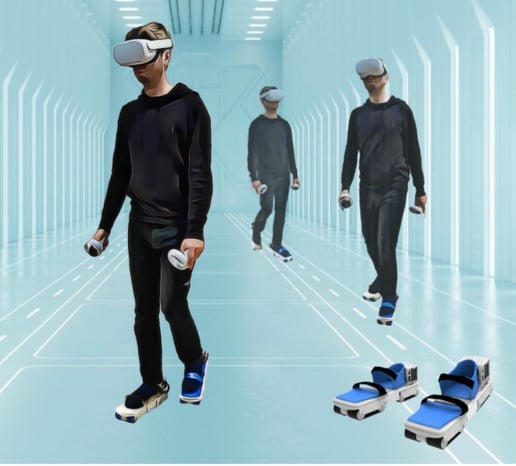The Walt Disney Company has revealed Holotile Floor, a new technology that the media conglomerate says could help people move around in any direction in virtual and augmented reality.
The floor was developed by Lanny Smoot, a Disney researcher with 106 patented inventions for the company. Smoot is also being inducted into the U.S. National Inventors Hall of Fame for his many groundbreaking inventions over the past 30 years, including Holotile.
Also read: Could VR Shoes Become the Next Immersive Buzz in the Metaverse?
Holotile floor: how does it work?
According to Disney, the Holotile is an omni-directional treadmill floor that aims to make movement in the virtual world realistic. It is made up of several individual rotating tiles that match a person’s steps on the floor with their avatar’s movements in the metaverse.
Because Holotile is omni-directional, people can move to the sides or in any direction they want without drifting away from the floor due to the many little steps taken as they move around. Smoot said the floor automatically helps you keep your feet on the ground.
The treadmill can support more than one person walking on it at the same time, and they can all walk independently. It means that users can interact within the same virtual space simultaneously without physical hindrances. This is especially helpful for group meetings or stage performances that involve dancing.
“It allows any number of people to have a shared virtual reality experience, walk an unlimited distance in any direction, and never collide or walk off its surface,” Disney wrote in a blog post.
“The Holotile can also be an insert in a theatrical stage, allowing performers to move and dance in new ways, or stage props and structures to move around or appear to set themselves up,” it added.
[embedded content]
Disney’s Holotile could bring a new level of realistic movement for people navigating the metaverse, who, until recently, appeared as legless avatars.
As seen in the YouTube video above, Lanny Smoot demonstrated how the treadmill works. The Disney inventor navigates a virtual reality environment using a VR headset, imitating walking on the ground.
He sits down on a chair, and the treadmill keeps shifting its surface until Smoot glides over the floor. Another person away from the floor waves their hand in circular motions to control Smoot’s movement in yet another demonstration of the Holotile’s capabilities.
“Imagine a number of people being in a room, being able to be somewhere else collaboratively, and moving around, seeing, and doing sightseeing,” Smoot said. “There are just so many applications for this type of technology, and we don’t know yet where it will be used.”
Walking in the metaverse
Virtual reality is a simulated environment, often accessed via VR headsets like Meta’s Quest range of headgear or Apple’s Vision Pro. The technology allows users to immerse themselves in a different world or scenario, which can either be realistic or imagined.
VR is one of the platforms that people use to enter the metaverse, a network of interconnected virtual worlds where users can meet, work, and interact. A key challenge for VR is how to move around in virtual worlds without breaking the immersion or feeling sick.
While the Holotile floor is still in early development, Disney hopes that its new technology could help solve these problems. But it is not the only company trying to add legs to avatars in the virtual world. There have been many attempts by others to solve VR locomotion, tech industry-speak for full body movement, and control solutions.
UK tech startup Freeaim Technologies is testing wearable shoes that enable users to walk “infinite distances in virtual reality in any direction” while staying within a small play space.
Dubbed ‘Freeaim VR Shoes,’ the device uses AI-powered motorized treadmills under the feet to help people move around in the virtual world. The treadmills track your every step, thanks to a network of sensors that read user intentions and adjust the terrain in real-time.


As MetaNews previously reported, Mark Zuckerberg’s Meta added legs to its Quest Home avatars after almost a year of waiting, in what is seen as a step closer to a more human-like metaverse.
However, the legs are only visible in a third-person view or when users interact with virtual mirrors, which means looking down won’t show the user their legs.
- SEO Powered Content & PR Distribution. Get Amplified Today.
- PlatoData.Network Vertical Generative Ai. Empower Yourself. Access Here.
- PlatoAiStream. Web3 Intelligence. Knowledge Amplified. Access Here.
- PlatoESG. Carbon, CleanTech, Energy, Environment, Solar, Waste Management. Access Here.
- PlatoHealth. Biotech and Clinical Trials Intelligence. Access Here.
- Source: https://metanews.com/disneys-holotile-floor-could-help-users-walk-in-the-metaverse/



